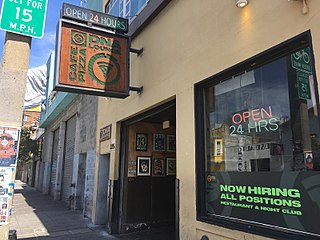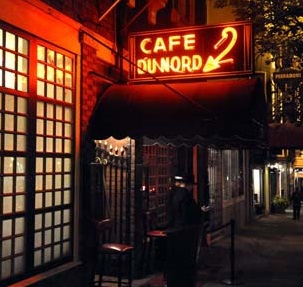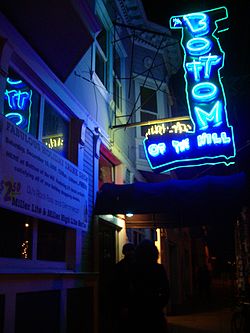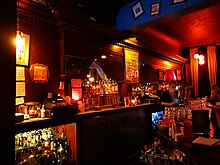
Dynamic range compression (DRC) or simply compression is an audio signal processing operation that reduces the volume of loud sounds or amplifies quiet sounds, thus reducing or compressing an audio signal's dynamic range. Compression is commonly used in sound recording and reproduction, broadcasting, live sound reinforcement and in some instrument amplifiers.

The Mabuhay Gardens, also known as The Fab Mab or The Mab, was a former San Francisco nightclub, located at 443 Broadway Street, in North Beach on the Broadway strip area best known for its striptease clubs. It closed in 1987.
Reverb is a weekly HBO music television series spotlighting emerging talent that ran for four seasons (1997–2001). Reverb captured the energy and spontaneity of live music by taking viewers on stage, backstage, and into the audience at some of the premier venues in the United States. Joining artists on tour, without special staging or second takes, Reverb created an unfiltered, authentic and intimate experience where the viewer became part of the live show dynamic between artist and fan. During its run, the show became the highest-rated, regularly scheduled music program on television. A joint effort of HBO and Warner Music Group, Reverb featured a wide variety of artists from major and independent record labels. Vanity Fair magazine called the show "a brilliant showcase of underground favorites."

DNA Lounge is an all-ages nightclub and restaurant/cafe in the SoMa district of San Francisco owned by Jamie Zawinski, a former Netscape programmer and open-source software hacker. The club features DJ dancing, live music, burlesque performances, and occasionally conferences, private parties, and film premieres.
The Mission District, commonly known as The Mission, is a neighborhood in San Francisco, California. One of the oldest neighborhoods in San Francisco, the Mission District's name is derived from Mission San Francisco de Asís, built in 1776 by the Spanish. The Mission is historically one of the most notable center of the city's Chicano/Mexican-American community.

A sound reinforcement system is the combination of microphones, signal processors, amplifiers, and loudspeakers in enclosures all controlled by a mixing console that makes live or pre-recorded sounds louder and may also distribute those sounds to a larger or more distant audience. In many situations, a sound reinforcement system is also used to enhance or alter the sound of the sources on the stage, typically by using electronic effects, such as reverb, as opposed to simply amplifying the sources unaltered.

Bernal Heights is a residential neighborhood in southeastern San Francisco, California. The prominent Bernal Heights hill overlooks the San Francisco skyline and features a microwave transmission tower. The nearby Sutro Tower can be seen from the Bernal Heights neighborhood.

The culture of San Francisco is major and diverse in terms of arts, music, cuisine, festivals, museums, and architecture but also is influenced heavily by Mexican culture due to its large Hispanic population, and its history as part of Spanish America and Mexico. San Francisco's diversity of cultures along with its eccentricities are so great that they have greatly influenced the country and the world at large over the years. In 2012, Bloomberg Businessweek voted San Francisco as America's Best City.
The Farm, also known as Crossroads Community, was an environmental art and performance art project that also operated as a community center. The Farm was located at the corner of Army Street and Potrero Avenue in San Francisco, California, from 1974 to 1987. It was founded by Bonnie Ora Sherk and Jack Wickert in 1974. The open space incorporated a major freeway interchange and is now site of Potrero del Sol Park.
Potrero Hill is a residential neighborhood in San Francisco, California. A working-class neighborhood until gentrification in the late 1990s, it is now home to mostly upper-income residents.

Dogpatch is a neighborhood in San Francisco, California, roughly half industrial and half residential. It was initially a working class neighborhood, but has experienced rapid gentrification since the 1990s. It now has similar demographics to its western neighbor Potrero Hill – an upper middle-class working professional neighborhood.

A bass amplifier is a musical instrument electronic device that uses electrical power to make lower-pitched instruments such as the bass guitar or double bass loud enough to be heard by the performers and audience. Bass amps typically consist of a preamplifier, tone controls, a power amplifier and one or more loudspeakers ("drivers") in a cabinet.
The Maritime Hall is a historic 3,000-capacity concert hall in San Francisco's South of Market neighborhood that operated from 1995 through 2001 as a popular music venue and nightclub. It was located at 450 Harrison Street at the Sailors Union of the Pacific building.

The Crocodile is a music club at 2505 1st Avenue at Wall Street in the Belltown neighborhood of Seattle, Washington, United States. Opened by Stephanie Dorgan as the "Crocodile Cafe" on April 30, 1991, it quickly became a fixture of the city's music scene. The Crocodile Cafe closed in December 2007, before being reopened as The Crocodile on March 19, 2009. Since then, the club has been owned by Alice in Chains' drummer Sean Kinney, manager Susan Silver, Portugal. The Man guitarist Eric Howk, Peggy Curtis, and Capitol Hill Block Party co-founder Marcus Charles. The Crocodile relocated to a bigger building at 2505 1st Avenue, four blocks away from its original location.

"Heart and Soul" is a song written by Mike Chapman and Nicky Chinn and made famous by Huey Lewis and the News. The song was first recorded by Exile in 1981 as the title track to their album Heart and Soul. Exile's single failed to crack the Billboard Hot 100, peaking at No. 102 on the Bubbling Under Hot 100 Singles chart. The song was also recorded by the BusBoys for their 1982 album American Worker.

Superfly is a New York-based marketing and event company. Founded in New Orleans in 1996 as a Superfly Presents, they produce and co-created Outside Lands Music and Arts Festival and previously owned and produced the Bonnaroo Music and Arts Festival. A marketing division was established in 2009, and in 2014 the company name was shortened to Superfly.

Cafe Du Nord is a 320-person capacity music venue in the basement level of the historic Swedish American Hall in San Francisco’s Upper Market neighborhood.

The Newport music scene, in and around Wales' third city, has been well documented and acclaimed for cultivating bands, singers, and famous music venues. It has been traditionally a rock city since the 1970s, but it has evolved over the years into forms of punk, 1990s alt-rock, and more recently metal and hip-hop.


















